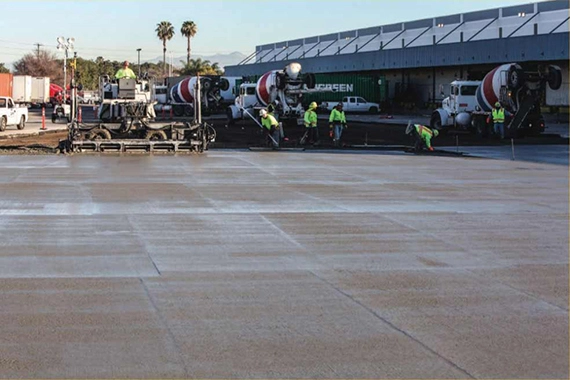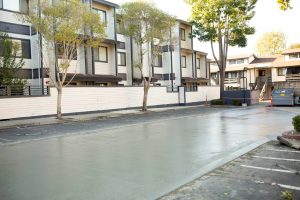
Concrete is extremely strong, diverse, low-maintenance, and resistant to damage. A well constructed and maintained concrete installation can easily last 20-30 years. The country’s first concrete street, laid in Bellefontaine, OH, in 1891, is still in service today!
GPM brings extensive expertise to concrete projects, including new concrete installation, reconstruction, and repairs. In addition to providing a perfectly finished surface, GPM concrete services include all the latest decorative enhancements, including:
- Dozens of Color Options
- Many Types of Finishes
- Numerous Stamps and Textures
Concrete Installation
GPM is well equipped and experienced with concrete paving projects of all sizes – commercial, industrial, and residential. Typical installations include:
- Sidewalks
- Curbs, Curb Ramps & Gutters
- Patios, Decks & Walkways
- Swales & Water Channels
We’ve hired GPM for multiple concrete jobs and have been completely satisfied. All aspects of the jobs were handled with professionalism and quality workmanship. Absolutely recommended! Keep up the great work GPM!
Mary K
The Right Concrete for Your Project
GPM offers a wide array of concrete services, from commercial-grade flatwork to intricate decorative concrete installation. GPM has the skill and expertise to complete any project.
- Color Options
Concrete can be colored from a virtually unlimited palette. Color may be added to concrete by adding pigments and using white cement rather than conventional gray cement. Other color treatment choices include using decorative stains or exposing colorful aggregates at the surface. GPM will help you select a color that fits your overall design. - Finishes
Concrete gives you many finish options based on utility (such as non-skid) or purely decorative effects (like ‘high luster’). Geometric patterns can make concrete resemble stone, brick, or tile paving. A “paneled” look is also possible, with rectangular, square, circular, or diamond panels in a range of sizes. Where safety concerns are paramount, concrete can be made to be slip-resistant and/or sparkling (high visibility). - Stamped Concrete
This is very popular, not only in commercial settings (with logos, etc.), but also for residential installations. There are a wide variety of standardized stamps as well as customized options.
Repair & Maintenance
Concrete is an extremely durable pavement solution, requiring little or no maintenance for several years. Premature cracking will be mitigated by scoring or installing expansion joints.
The GPM Difference
By embracing change in pursuit of excellence, General Pavement Management has enjoyed over 30 years of successful service to residential communities, commercial properties, and industrial facilities. Spanning from Los Angeles to San Luis Obispo, we’d be happy to serve you, too. Contact Us for a free consultation on how to make concrete work for your unique project.
GPM Pavement Concrete FAQs
What types of projects is concrete best for?
Concrete is perfect for a wide variety of building projects. It is popular for its strength, durability, and versatility. Concrete is suitable for floors, driveways, parking lots, patios, sidewalks, curbs, water channels, and so much more. Ask us if concrete is right for your next project!
How do you determine if concrete or pavement should be used for parking lots, driveways, etc?
We look at a variety of factors. Concrete costs a little more on installation, but its maintenance costs are less in the long run. Concrete offers the option of decorative colors or stamped finishes.
Does concrete need to be sealed to protect it from the California weather?
Concrete does not need to be sealed, but we recommend it. Here’s why: Concrete is porous and water will seep in, which can cause problems for outdoor concrete in low temperatures and can also increase the chances for mold to grow. Sealed floors also prevent damage from the sun, premature cracking, and protects colors from fading.
What is a concrete finisher?
A concrete finisher is a professional who smooths the surface layer of concrete. They may also apply treatments, install expansion joints, and add scoring, color, or stamping to the surface.
What factors go into calculating how much concrete is needed?
The amount of concrete needed for a project is measured by the length, width, and depth of the area. An easy way to remember it is the math formula W x L x H (width x length x height). To find the length and width, simply measure the project area in inches. The height you’re calculating is actually the depth of concrete slab or footing. Although this varies with a project, you can estimate four to six inches for many residential projects. Now use the formula to find out how many inches of concrete is needed and convert to square feet.
What is “scoring” and “expansion joints” and why are they important?
Scoring concrete, also called sawcutting, is when grooves are cut directly into the cured concrete. The grooves can be cut into simple designs and add texture to a smooth surface.
Expansion joints are gaps between the concrete and an adjoining surface that allows the concrete to expand or contract without cracking the surface.
How long does it take General Pavement Management to complete a concrete job?
It depends on the size of the project, but we pride ourselves on our efficiency and dependability. When we deliver our project estimate, we stick to our estimated project completion date and cost.


